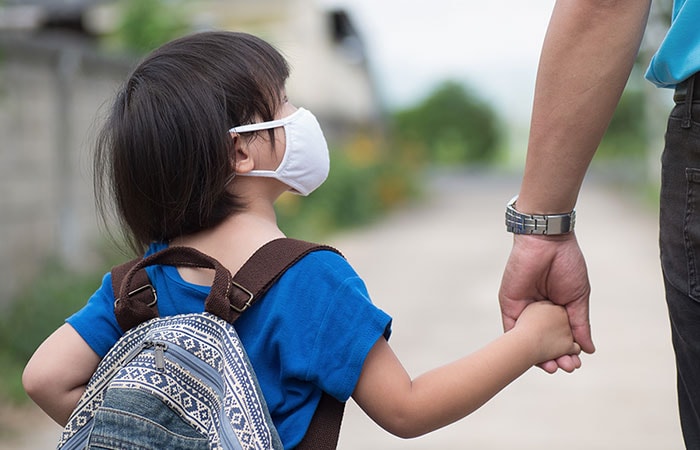Español (Spanish)PodcastTransitioning Back to School or Early Child Education
Listen to podcast | Download transcript pdf icon[PDF – 27 KB]
Transitioning back to early childhood programs or school— or starting them for the first time—can create extra challenges during a pandemic. Learn what parents and teachers can do to help children make a successful transition to in-person learning and care.
Reopening means many new starts
Many early care and education programs stayed open during the COVID-19 pandemic to provide needed care. But for many families, the pandemic meant keeping their children at home. With more programs and schools opening up for in-person learning, this means more children will be away from home again after a long break. And many babies who were born just before or during the COVID-19 pandemic may have stayed home rather than starting an early care and education program1. For these children and their parents— including caregivers who have the role of parent—an early care and education program will be a brand new experience.
Transitions can be hard for children and families

Young children are often wary of strangers and want to stay close to their parents and other familiar and trusted caregivers. Until they are old enough to talk clearly about their feelings, it’s hard to explain to them that a new caregiver is going to protect them, which means it takes time for children to get used to new people. School-aged children who are sensitive or easily worried, or those who have developmental delays, may need extra time to adjust. It’s often easier for young children to make the transition if they have spent some time with their parents and the new person together. Parents also often worry about their child making the transition, and it’s easier for parents to keep calm and be reassuring if they know their child’s teacher and feel comfortable with them.
Transition in a time of physical distancing, masks, and extra stress is extra hard
During the COVID-19 pandemic, it has been very important to keep physical distance between people who don’t live together. Early care and education programs and schools have had to limit visitors and changed drop-off and pick-up procedures to limit contact; teachers and children older than age 2 years have had to wear masks. Facial expressions are used to help communicate feelings and provide reassurance, so being around masked faces can add to feelings of uncertainty. For children who return to in-person care, changes to the space and to routines might make everything look and feel different. Further, children may be aware that COVID-19 risk has to do with being around other people and may worry about getting sick. Children are generally flexible and can adapt, but strategies to protect children’s health may make transitions to new situations and new people harder. Parents may feel less comfortable with letting their child start an early care and education program because they can’t easily visit and may know less about the program and the teacher than they normally would.
In addition, the COVID-19 pandemic has increased stress, fear, and worry for many families. Worries about sickness, finances, and isolation, coping with grief from loss, and having less outside help has made parenting more stressful. Many families report increased behavior problems in their children, including anxiety and acting out2. Schools and early care and education programs can help children and families by promoting social and emotional learning. Making the transition from home to school may be harder for children with developmental, behavioral, or emotional problems. Teachers, parents, and programs can help children by planning the transition, making strong connections, and establishing new routines. With the right support, children can adjust to their new program, make new friends, learn new things, and thrive.
What parents and teachers can do to support children’s transition
Skilled early care and education providers know how to help children adjust. But in a pandemic, and after long periods without being in care, it may be good to put a little extra support into the transitions. Here are some tips to help families with the transition.Beyond School Supplies: Back to School Reminders & Readiness
Teachers and administrators can:
- Provide virtual connections with parents, such as video calls and phone meetings. Consider connecting parents to other parents to learn about the program and share experiences.
- Create virtual tours so that parents can see the facility and classrooms and imagine what it would be like for their child to attend. Programs can allow visitors who are fully vaccinated. Fully vaccinated staff can also hold in-person meetings indoors with members of a single household if not everyone is fully vaccinated.
- Consider in-person meetings outside on the playground to let children meet the teacher and other children before starting the program.
- Create a daily structure and routines to help children learn what to expect.
- Share information with parents of returning children about how daily routines might be different because of the COVID-19 pandemic, and how to help prepare their child for any changes.
- Provide frequent communication to parents about their children’s time in the program.
Learn more about what teachers can do.pdf iconexternal icon
Parents can:
- Connect with other parents who have children in the same program who can provide information and make them more comfortable with the program.
- Talk with teachers about the best way to separate from their child at the start of the day—brief goodbyes are often best.
- Try to stay calm and reassuring during transition—using a calm voice, with a relaxed face and body to let their child know that they wouldn’t leave them if the child were not safe and protected.
- Take care of themselves during stressful times so they can be better equipped to take care of others.
- Find resources to learn how to promote resilience and reduce anxiety.external icon
- Remember that this is a phase—building new relationships is a skill, and with support, children can be resilient. Even if it’s hard to separate, they will gain a new trusted relationship with their new teacher and feel more secure.
Parents with concerns can:
- Make sure their child has a daily, predictable routine, with regular times for healthy meals, naps, and night sleep at home. Having a rested body and knowing what to expect at home helps children cope.
- Monitor their child’s developmental milestones and learn what to do if there are concerns.
- Talk to a healthcare professional if their child’s symptoms of anxiety or behavior problems are severe or persistent.
- Contact a mental healthcare professional for parent training and support so parents can help their child.
- Find resources for themselves if they are sad, worried, or stressed.external icon
- For children with new concerns that persist, ask the school for an evaluation to see if the child may need special education services or accommodations.external icon For children with identified disabilities, ask the program to review their Individualized Education Program (IEP).
Schools and ECE Programs can:
- Provide staff development and support for teachers if there are more children than usual who have difficulty with transition.
- Review and enhance resources for staff health and well-being.external icon
- Make sure that teachers have access to mental health support if they are dealing with their own stress, loss, or trauma related to the COVID-19 pandemic.
- Include resources for social-emotional learning.external icon
- Seek support from early childhood mental health consultants.external icon
More information and resources
- CDC’s Guidance for Operating Early Care and Education Programs
- CDC’s Information on Helping Children Cope
- CDC’s Information on Managing Stress and Anxiety during a Pandemic
- CDC Information on Children’s Mental Health
- NASEM Covid-19 Promoting Emotional Well-being and Resilience for Parents and Childrenexternal icon
- CDC’s How Right Now Campaignexternal icon
- CDC’s Positive Parenting Tips
- CDC’s Back to School Preparedness
- CDC’s Food Assistance and Food System Resources for Families Seeking Food Assistance
- CDC’s Tips to Enhance Immunity
Partner resources
- Head Start Heals: Transitioning Back to School pdf icon[PDF – 207 KB]external icon
- Head Start Heals Campaignexternal icon
- Head Start: COVID-19 and Mental Health and Wellnessexternal icon
- Fostering Healthy Social and Emotional Development in Young Children pdf icon[PDF – 286 KB]external icon
- Social and Emotional Learning for PreK-12external icon
- National Association for the Education of Young Children: Promoting Social and Emotional Healthexternal icon
- Innovative Practices for Reopening Schools and Campusesexternal icon
- Promoting Staff Wellness for Early Learning Programsexternal icon
- Emergencies and National Disasters: Helping Children and Families Copeexternal icon
References
- https://www.americanprogress.org/issues/early-childhood/news/2020/11/10/492795/decreased-enrollment-higher-operating-costs-child-care-hit-hard-amid-covid-19/external icon
- https://nieer.org/research-report/seven-impacts-of-the-pandemic-on-young-children-and-their-parents-initial-findings-from-nieers-december-2020-preschool-learning-activities-surveyexternal icon

